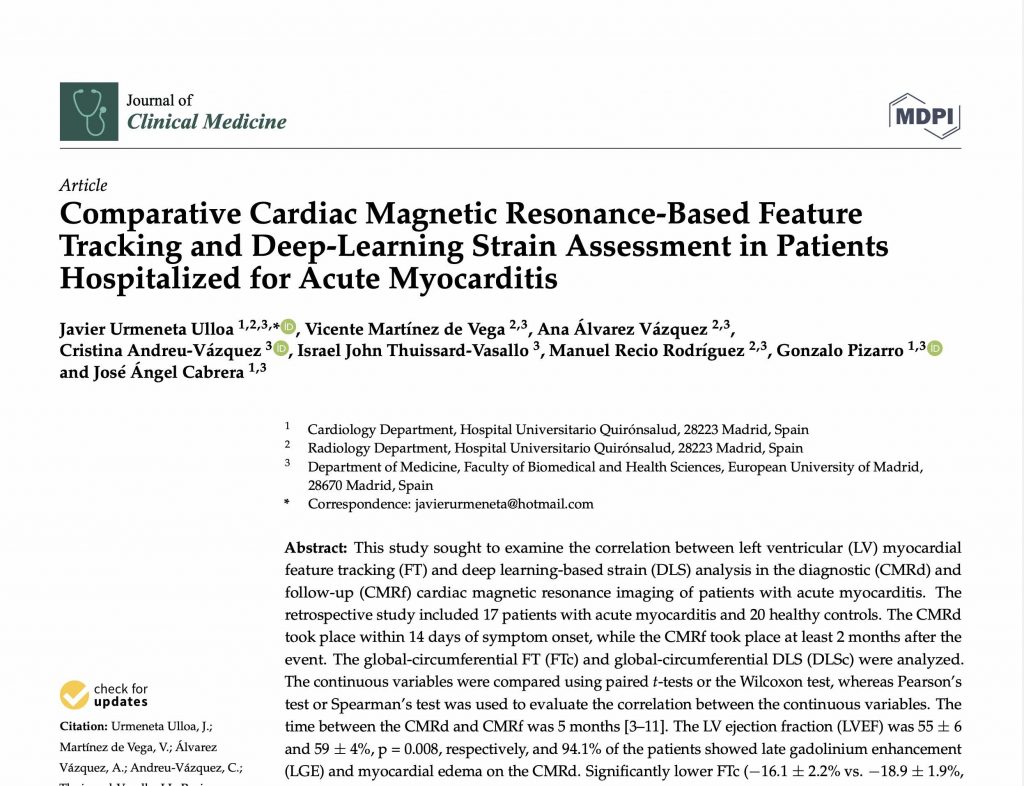Javier Urmeneta Ulloa 1,2,3,* Cristina Andreu-Vázquez 3 and José Ángel Cabrera 1,3, Vicente Martínez de Vega 2,3, Ana Álvarez Vázquez 2,3, , Israel John Thuissard-Vasallo 3, Manuel Recio Rodríguez 2,3, Gonzalo Pizarro 1,3
1 Cardiology Department, Hospital Universitario Quirónsalud, 28223 Madrid, Spain
2 Radiology Department, Hospital Universitario Quirónsalud, 28223 Madrid, Spain
3 Department of Medicine, Faculty of Biomedical and Health Sciences, European University of Madrid, 28670 Madrid, Spain
Abstract:
This study sought to examine the correlation between left ventricular (LV) myocardial feature tracking (FT) and deep learning-based strain (DLS) analysis in the diagnostic (CMRd) and follow-up (CMRf) cardiac magnetic resonance imaging of patients with acute myocarditis. The retrospective study included 17 patients with acute myocarditis and 20 healthy controls.
The CMRd took place within 14 days of symptom onset, while the CMRf took place at least 2 months after the event. The global-circumferential FT (FTc) and global-circumferential DLS (DLSc) were analyzed. The continuous variables were compared using paired t-tests or the Wilcoxon test, whereas Pearson’s test or Spearman’s test was used to evaluate the correlation between the continuous variables. The time between the CMRd and CMRf was 5 months [3–11]. T
he LV ejection fraction (LVEF) was 55 ± 6 and 59 ± 4%, p = 0.008, respectively, and 94.1% of the patients showed late gadolinium enhancement (LGE) and myocardial edema on the CMRd. Significantly lower FTc (−16.1 ± 2.2% vs. −18.9 ± 1.9%, p = 0.001) and DLSc (−38.1 ± 5.2% vs. −41.3 ± 4.5%, p = 0.015) were observed with respect to the controls.
Significant increases in the FTc (−16.1 ± 2.2 vs. −17.5 ± 1.9%, p = 0.016) and DLSc (−38.1 ± 5.2 vs. −39.8 ± 3.9%, p = 0.049) were found between the CMRd and CMRf, which were unrelated to the LGE. The LVEF correlated well with the FTc (r = 0.840) and DLSc (r = 0.760). Both techniques had excellent reproducibility, with high intra- (FTc = 0.980, DLSc = 1.000) and inter- observer (FTc = 0.970, DLSc = 0.980) correlation. There was correlation between the LV DLSc/FTc and LVEF in the patients with acute myocarditis according to the CMRd and CMRf.

